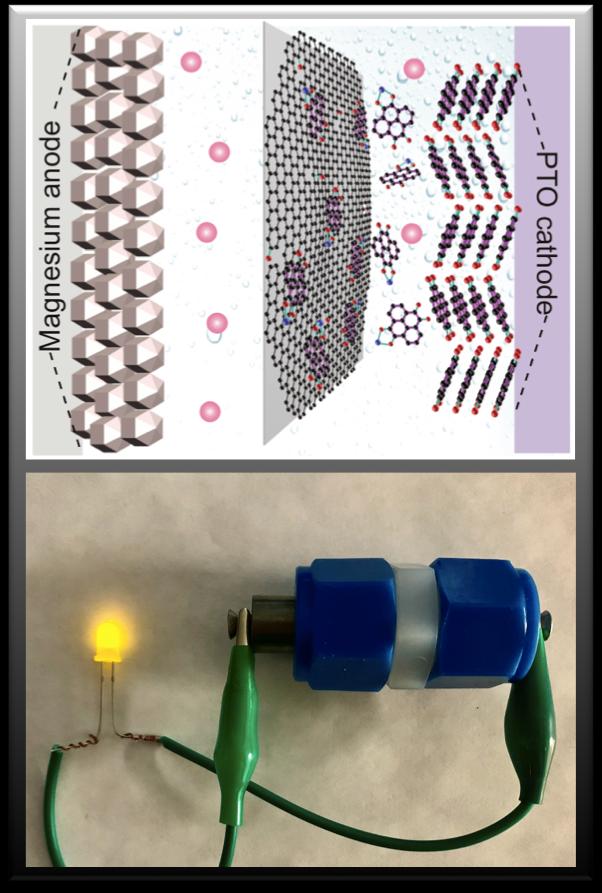New cathode, electrolyte allow high-power battery previously considered impossible

Credit: University of Houston
Magnesium batteries have long been considered a potentially safer and less expensive alternative to lithium-ion batteries, but previous versions have been severely limited in the power they delivered.
Researchers from the University of Houston and the Toyota Research Institute of North America (TRINA) report in Nature Energy that they have developed a new cathode and electrolyte – previously the limiting factors for a high-energy magnesium battery – to demonstrate a magnesium battery capable of operating at room temperature and delivering a power density comparable to that offered by lithium-ion batteries.
As the need for grid-scale energy storage and other applications becomes more pressing, researchers have sought less expensive and more readily available alternatives to lithium.
Magnesium ions hold twice the charge of lithium, while having a similar ionic radius. As a result, magnesium dissociation from electrolytes and its diffusion in the electrode, two essential processes that take place in classical intercalation cathodes, are sluggish at room temperature, leading to the low power performance.
One approach to addressing these challenges is to improve the chemical reactions at elevated temperatures. The other circumvents the difficulties by storing magnesium cation in its complex forms. Neither approach is practical.
Yan Yao, Cullen Professor of Electrical and Computer Engineering at the University of Houston and co-corresponding author for the paper, said the groundbreaking results came from combining both an organic quinone cathode and a new tailored boron cluster-based electrolyte solution.
“We demonstrated a heterogeneous enolization redox chemistry to create a cathode which is not hampered by the ionic dissociation and solid-state diffusion challenges that have prevented magnesium batteries from operating efficiently at room temperature,” Yao said. “This new class of redox chemistry bypasses the need of solid-state intercalation while solely storing magnesium, instead of its complex forms, creating a new paradigm in magnesium battery electrode design.”
Yao, who is also a principle investigator with the Texas Center for Superconductivity at UH (TcSUH), is a leader in the development of multivalent metal-ion batteries. His group recently published a review article in Nature Energy on the roadmap to better multivalent batteries.
TRINA researchers have made tremendous advancements in the magnesium battery field, including developing highly recognized, efficient electrolytes based on boron cluster anions. However, these electrolytes had limitations in supporting high battery cycling rates.
“We had hints that electrolytes based on these weakly coordinating anions in principle could have the potential to support very high cycling rates, so we worked on tweaking their properties,” said Rana Mohtadi, a Principal Scientist in the materials research department at TRINA and co-corresponding author. “We tackled this by turning our attention to the solvent in order to reduce its binding to the magnesium ions and improve the bulk transport kinetics.”
“We were fascinated that the magnesium plated from the modified electrolyte remained smooth even under ultrahigh cycling rates. We believe this unveils a new facet in magnesium battery electrochemistry.”
The work is in part a continuation of earlier efforts described in 2018 in Joule and involved many of the same researchers. In addition to Yao and Mohtadi, coauthors include first authors Hui Dong, formerly a member of Yao’s lab and now a post-doctoral researcher at the University of Texas at Austin, and Oscar Tutusaus of TRINA; Yanliang Liang and Ye Zhang of UH and TcSUH; and Zachary Lebens-Higgins and Wanli Yang of the Lawrence Berkeley National Laboratory. Lebens-Higgins also is affiliated with the Binghamton University.
“The new battery is nearly two orders of magnitude higher than the power density achieved by previous magnesium batteries,” Dong said. “The battery was able to continue operating for over 200 cycles with around 82% capacity retention, showing high stability. We can further improve cycling stability by tailoring the properties of the membrane with enhanced intermediate trapping capability.”
Tutusaus said the work suggests the next steps toward high-performance magnesium batteries.
“Our results set the direction for developing high-performance cathode materials and electrolyte solutions for magnesium batteries and unearth new possibilities for using energy-dense metals for fast energy storage,” he said.
###
Media Contact
Jeannie Kever
[email protected]
Original Source
https:/




